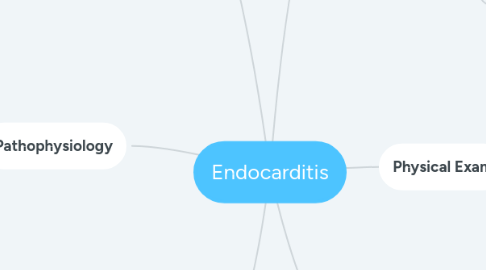
1. Pathophysiology
1.1. Bacteraemia (bacteria in bloom stream) Infection from another body site Bacteria can 'stick' to heart valves Embolism caused by bacteria on the valve can travel to other body sites More commonly occurs in abnormal heart valves
1.1.1. Acute
1.1.1.1. Bacterial: S. Aureus, Pneumococcus, S. pyogenes, Enterococcus
1.1.1.2. Prosthetic valve endocarditis
1.1.1.3. Pt presents high fever, fast heart rate. fatigue and rapid and extensive heart valve damage causing symptoms of heart failure. Develops suddenly and may become life threatening within days
1.1.2. Subacute or chronic
1.1.2.1. Bacterial: Viridians, Streptococci, Enterococcus
1.1.2.2. Patient presents fatigue, mild fever , a moderately fast heart rate, weight loss, sweating, and a low red blood cell count. Develops slowly over a period of weeks to several months.
2. History/Progression
2.1. Fever and sweat
2.2. Weight loss
2.3. Exposure or risk factor
2.3.1. Poor dental hygiene
2.3.2. Implanted cardiovascular medical devices
2.3.3. Chronic skin disorders
2.3.4. Infectious diseases
2.3.5. Burns
2.4. New sign of heart failure
2.4.1. Breathlessness
2.5. Chills, dyspnea, weakness
3. Common Medical Treatment
3.1. Intravenous antibiotics
3.1.1. Long term (6 weeks)
3.2. Surgery
3.2.1. Valve replacement
4. Risk Factor
4.1. Valve Disease
4.2. Congenital heart disease
4.3. Leaky valves
4.4. Dental Infection
4.5. Intravenous drug use
4.6. Immunosuppresion
4.7. Rheumatic heart disease
4.8. Previous endocarditis
5. Current Testing
5.1. Blood cultures
5.1.1. 3 sets are contained when the first 24 hours
5.2. Echocardiography
6. Physical Exam
6.1. Fever
6.2. New murmur
6.3. Haematuria
6.4. Peripheral findings
6.4.1. Splinter haemorrhages
6.4.1.1. Nail bed with haermorrhages
6.4.2. Janeway lesions
6.4.2.1. Painless little red lesion in the hand
6.4.3. Osler nodes
6.4.3.1. Painful little red lesion in the hand

